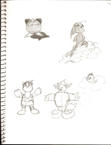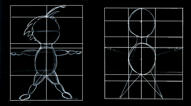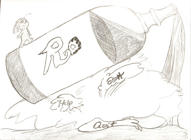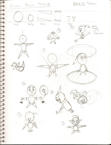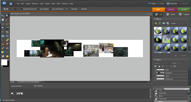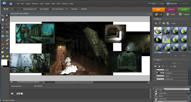- State the rules of your games.
(1) Controls: A - left/backwards, S - down, D - right/forward, W - jump, SPACEBAR - fire weapon.
(2) Ro's state endures as long has he has available energy.
(3) Warning: Attacking real scientists may cause physical injury, do not attempt.
- There are 8 kinds of rules (see book chapter). Consider each of these, and discuss each one of them with respect to your game. All games should consider at least a few of these 8.
---> The eight types of rules are:
(1) Operational Rules
The operational rules of Ro are ASDW move the character, A- left/back, S- down, D- right/forward, W- jump, Spacebar - fire weapon.
(2) Foundational Rules
Ro's state endures as long has he has available energy.
(3) Behavioral Rules
Warning: Attacking real scientists may cause physical injury, do not attempt.
(4) Written Rules
Players guide Ro, an endangered lab experiment through moving trials using his two states, heavy and light which each have their purpose in the game. Collecting bottles helps Ro gain energy to escape the lab while depleted energy leads to game over and being captured as a lab experiment! Attack enemies to travel from room to room to the final destination. Items are important in furthering your quest so keep a look out for them!
(5) Laws
Ro does not have any laws involved in gameplay since it does not involve success of failure of a player does not hold highly competitive tactics as its most important factor.
(6) Official Rules
Official rules would not be used for Ro beyond the basic controls and goals of the main character.
(7) Advisory Rules
Most advisory rules are overlooked in Ro to make the game more challenging for the player but in general players should look for objects and collect them while being aware of their surroundings.
(8) House Rules
There are no general house rules but players may decided to play with an element of time or other challenges to make the game more or less difficult.
- What is the ultimate goal of your game. Is the goal achievable?
---> The ultimate goal of Ro is to guide the character to safely although our group is not currently sure if the entire goal will be playable in the span of the class. For example in a full game Ro would travel through various levels and finally emerge from the lab in the final level after defeating the "boss" scientist bent on capturing him but we do not currently plan to incorporate a great deal of levels due to the time involved in creating those levels.
- Is there more than a single sub-goal? Are they related to each other? Why? Why not? Would it help your game if they were?
---> Yes, there will be sub goals throughout the game since it is somewhat puzzle/adventure based. Events will not be listed here because it would take away from the gameplay but they are related to each other in that they must all be overcome to travel further in the game and towards the character's goal of escaping the lab. However, they will not be identical because players would not be challenged unless they were somewhat different obstacles. It would probably hurt the game if they obstacles we very similar in every point to go further.
- Are the goals rewarding? How?
---> Overall the goals should be rewarding generally to players by giving them the "Ah ha" feeling about solving quick-witted puzzles to avoid an unfortunate game over! No one likes losing after all and make it even a little further when it is difficult can be very enjoyable as long as the difficulties are balanced and not too overwhelming from the start.
- Can the players control their own goals?
---> Players can create a set of house rules such as "So and so can you beat my time of XX:XX minutes for the whole game?" A new level of strategy would be involved to solve the puzzles on an even more strenuous time limitation. However other than goals the players come up with, most goals are programmed or planned into the game from the start.
- What forms of balance does your game have? Describe them.
---> The sense of balance Ro has embedded in the design is the level of detail. We carefully planned out what to detail and what to hold back. Although we would have loved for everything to be detailed it was beyond both the power of current standard computers(a non-gaming computer) and too time intensive for the time given in this class. Although we know everyone love something nice to look at so we are detailing certain easier to control elements of the game such as the backgrounds and possibly floors with 2d art and and more detail on the characters in comparison to the level's fixed objects(such as ledges for the player to stand on).
The book also mentioned "Familar worlds do not need too much detail." Although I'm sure many of us could debate that, on a basic level that is true and since our game takes place in a lab, most people are familar with the objects found there and can imagine the detail.
- What are the operative actions of your game?
---> The main actions of our game are maneuvering obstacles in various ways with ASDW and firing with spacebar to defeat enemies.
- What are the resultant actions of your game?
---> A cleared path to go forward from defeated enemies and openings from blocked obstacles result from the operative actions.
- Discuss the real and virtual skill developed in your game.
---> The real skills developed in Ro are thinking tactically in short time frames which can cause people to view real world problems in a more abstract way instead of always relying on the "tried and true" methods which always work.
The virtual skills a player recieves are weapon tactics, object manipulation, and virtual problem solving.
- Discuss the notion of balance in your game (chapter 11)
---> Some things Team 1 is doing to physically balance our game is documenting our game design model and modifying it as we go further. Also we have a plan to balance the game, for example not long ago in order to balance the game we somewhat got rid of Ro's normal state. He might be used in the storyline but will not be used in gameplay at least at the current state we are using the characters.

